Welcome to the joint seminars
We will hold a joint seminar from May 07th to May 09th. Anyone interested in the seminar is welcome to join. Below, you will find the timetable and details about the talks.
Joint Seminars:
https://reg.shanghaitech.edu.cn/cts/wufx2025/announcement.php?aid=26
Wednesday 07 May: Shanghai Jiaotong University Joint Seminar on Ultrafast Science
Program: https://reg.shanghaitech.edu.cn/cts/wufx2025/show_detail.php?aid=269&type=pdf&sp=F01
Thursday 08 May: ShanghaiTech University Joint Seminar on Intense Field Science (SPST 5-105)
09:00-10:00
Marcus Dahlström, Lund University
Theory for Ultrafast Dynamical Photoemission: cases of dressed continuum, dressed atom and dressed ion
10:00-11:00
Alexander Kuleff, Heidelberg University
Interatomic Coulombic Decay: The power of non-local relaxation mechanisms
11:00-12:00
Nina Rohringer, Deutsches Elektronen-Synchrotron (DESY)
X-ray Superfluorescence.
Friday 09 May: ShanghaiTech University Joint Seminar on AMO@XFEL (SPST 5-105)
09:00-10:30
Daniel Rolles, Kansas State University
Gas-phase photochemistry studied by time-resolved photoelectron spectroscopy with free-electron lasers.
10:30-12:00
Enrico Allaria, Elettra Sincrotrone Trieste
User-tailored experiments at free-electron laser facilities: the experience at FERMI
Friday 09 May, East China Normal University Joint Seminar on Ultrafast Science
Program: https://reg.shanghaitech.edu.cn/cts/wufx2025/show_detail.php?aid=270&type=pdf&sp=F01
---------------------------------------------------------------------------------------------------------------------------
Thursday 8 May: ShanghaiTech University Joint Seminar on Intense Field Science (SPST 5-105)
---------------------------------------------------------------------------------------------------------------------------
Marcus Dahlström, Lund University
Theory for Ultrafast Dynamical Photoemission: cases of dressed continuum, dressed atom and dressed ion
Free electron laser pulses at short wavelengths can be used to study strong coupling in atoms on ultrafast timescales. Phenomena include strong-field ionization from Rabi cycling atoms, dressed-atom stabilization, atomic stabilization in superintense laser fields, dynamic interference, and field-induced entanglement between photoelectrons and ions. In this seminar, various theoretical approaches will be reviewed for this area of physics, with a focus on analytical methods, such as few-level effective Hamiltonians and the Volkov propagator, with important interconnected concepts, such as gauge transformations and unitary transformations for time-dependent problems, being described in some detail. Highlights of the seminar will include strong-field Rabi dynamics and laser-assisted dynamic interference.
Alexander Kuleff, Heidelberg University
Interatomic Coulombic Decay: The power of non-local relaxation mechanisms
Interatomic Coulombic Decay (ICD) is a fundamental non-local relaxation mechanism occurring in weakly bound systems, where the excess energy of an excited atom or molecule is efficiently transferred to a neighboring species, leading to its ionization. Over the past decades, ICD has been recognized as a highly efficient mechanism for energy dissipation in various environments, from rare gas clusters to complex biological systems. In this talk, I will introduce the basic principles of ICD and explore its role in multiply excited clusters, where ICD cascades can sequentially ionize multiple atoms, leading to enhanced charge redistribution and fragmentation. The discussion will then focus on the relevance of ICD in the radiation damage of biomatter, emphasizing recent results on ICD and related processes in solvated biomolecules. In particular, the interplay between ICD and other decay pathways, such as Resonant-Auger-ICD cascades, will be presented in the context of radiation-induced damage at the molecular level. By highlighting recent theoretical and experimental advances, this talk aims to provide a comprehensive overview of how ICD and its cascading effects shape energy dissipation and charge redistribution in complex systems, with significant implications for radiation biology and medical applications.
Nina Rohringer, DESY
X-ray Superfluorescence
X-ray free-electron lasers (XFELs) open new avenues towards studying collective x-ray emission and nonlinear x-ray matter interaction. In this talk I will give a retrospective on the phenomenon of collective spontaneous x-ray emission following ultrafast inner-shell photoinization (x-ray superfluorescence). Theory as well as experimental achievements will be discussed. X-ray superfluorescence has been demonstrated in atomic gases in the soft x-ray range, in rare-gases and clusters in the XUV, and in solids and liquids in the hard x-ray range. As opposed to the XFEL pulses that are based on the process of self-amplified spontaneous emission (SASE) and have limited temporal coherence, x-ray superfluorescence produces phase-stable, ultrabright x-ray pulses of fs and sub-fs duration. Using this principle of inner-shell x-ray lasing, I discuss two new proposals for further tailoring x-ray pulses: By combining collective x-ray emission and Bragg scattering in a crystal --- an x-ray analogue of a distributed feedback laser --- it is possible to create phase-stable pairs of x-ray pulses in the hard x-ray spectral region. Furthermore, we propose a set-up for an x-ray laser oscillator that combines a Bragg cavity, serving as monochromator, and a multi-pass superfluorescent emission [8], thereby offering the opportunity to create x-ray pulses of unprecedented brightness and narrow bandwidth.
---------------------------------------------------------------------------------------------------------------------------
Friday 9 May: ShanghaiTech University Joint Seminar on AMO@XFEL (SPST 5-105)
---------------------------------------------------------------------------------------------------------------------------
Daniel Rolles, Kansas State University
Gas-phase photochemistry studied by time-resolved photoelectron spectroscopy with free-electron lasers
Time-resolved photoelectron spectroscopy (TRPES) is a powerful tool to study electronic de-excitation and chemical changes during photochemical reactions. However, when using visible or ultraviolet (UV) pulses as probe, the observation window is often limited to low-binding-energy excited states near the Franck-Condon region. This limitation can be overcome when probing the reaction with extreme ultraviolet (XUV) pulses produced, e.g., from a free-electron laser (FEL) or a high harmonic generation (HHG) source. This allows for the entire reaction pathway to be probed, including any structural rearrangement or dissociation occurring on the electronic ground state. I will present two examples of XUV TRPES experiments performed at the FERMI FEL that take advantage of these capabilities: an investigation of the UV-(266-nm)-induced ring-opening reaction of the prototypical heterocyclic molecule thiophenone (C4H4OS), and a study of the UV-(200-nm)-induced ring-reconfiguration of the quadricyclane-norbornadiene (C7H8) photo switch. I will also compare the findings to results obtained for the same molecules with other ultrafast techniques to highlight the strengths and weaknesses of each method and the power of a multi-modal probing approach. Finally, I will present results from a time-resolved inner-shell photoelectron spectroscopy experiment studying intramolecular charge transfer by taking advantage of the site-specificity of inner-shell photoemission.
Enrico Allaria, Elettra Sincrotrone Trieste
User-tailored experiments at free-electron laser facilities: the experience at FERMI
Free Electron Lasers (FELs) are unique facilities that merge characteristics of lasers such as coherence and short pulses with the broad tunability extending into the X-ray range. This combination offers significant opportunities for scientists to conduct time-resolved X-ray experiments, providing new insights into dynamic processes at the atomic and molecular levels. Unlike synchrotron radiation facilities, which can support multiple concurrent experiments, FELs typically focus on one or two experiments at a time. This approach provides added flexibility for users, allowing for adjustments to the FEL configuration and photon properties to better suit specific experimental requirements, requiring a close collaboration between FEL/accelerator experts and user and beamline scientists. Throughout the years, the FERMI team has actively engaged with various groups and the user community to optimize the utilization of the unique capabilities of the FERMI FEL.
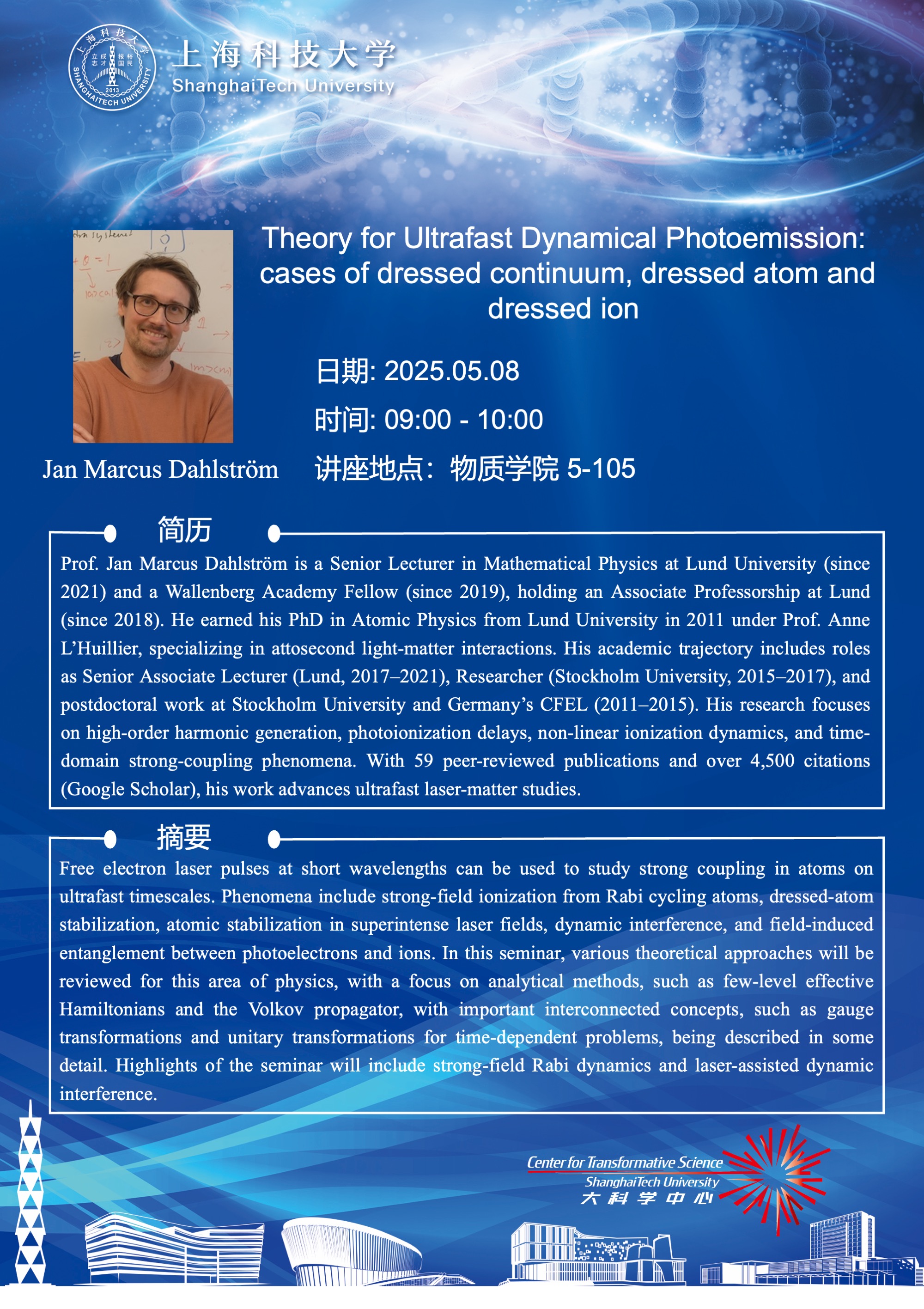
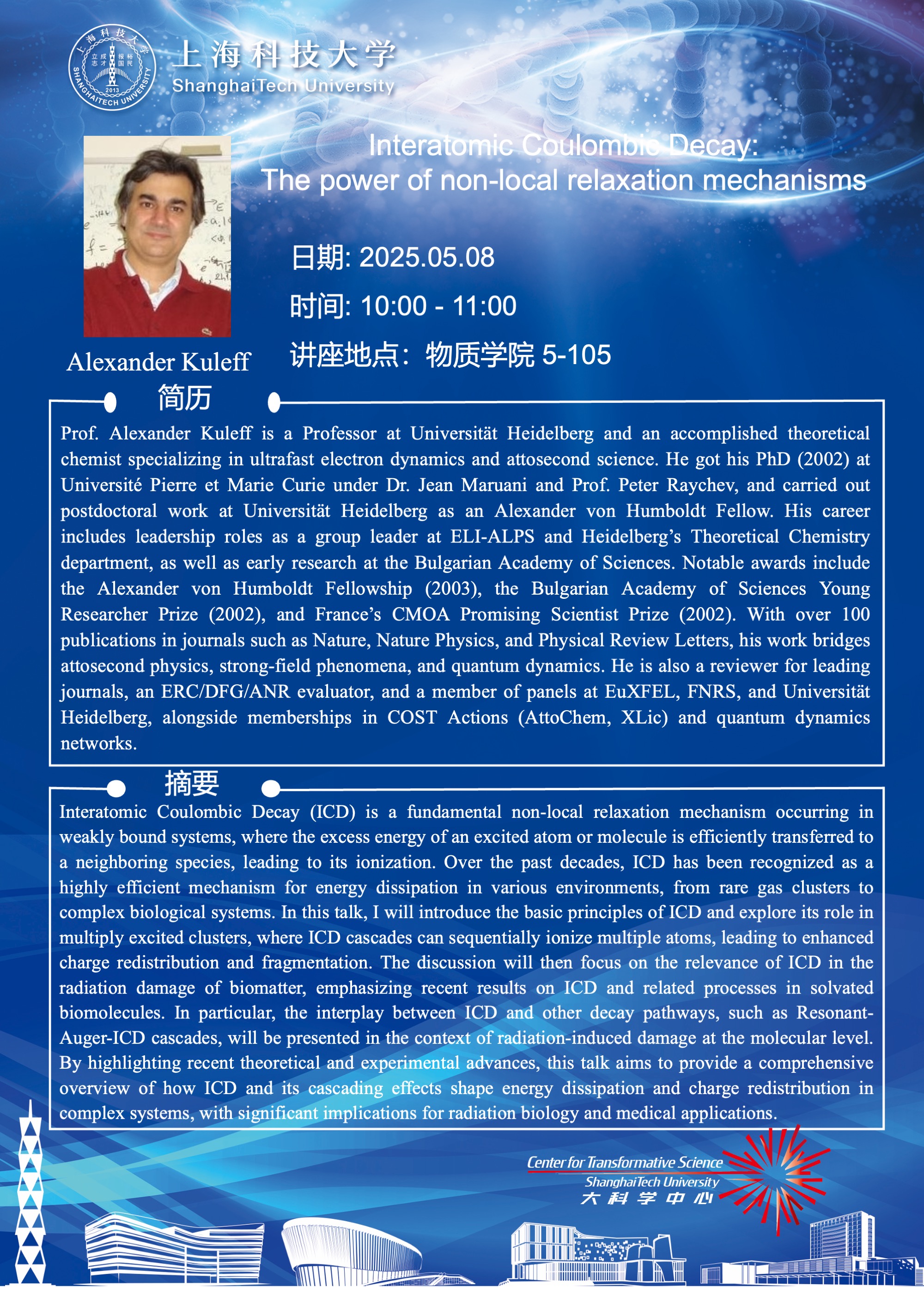
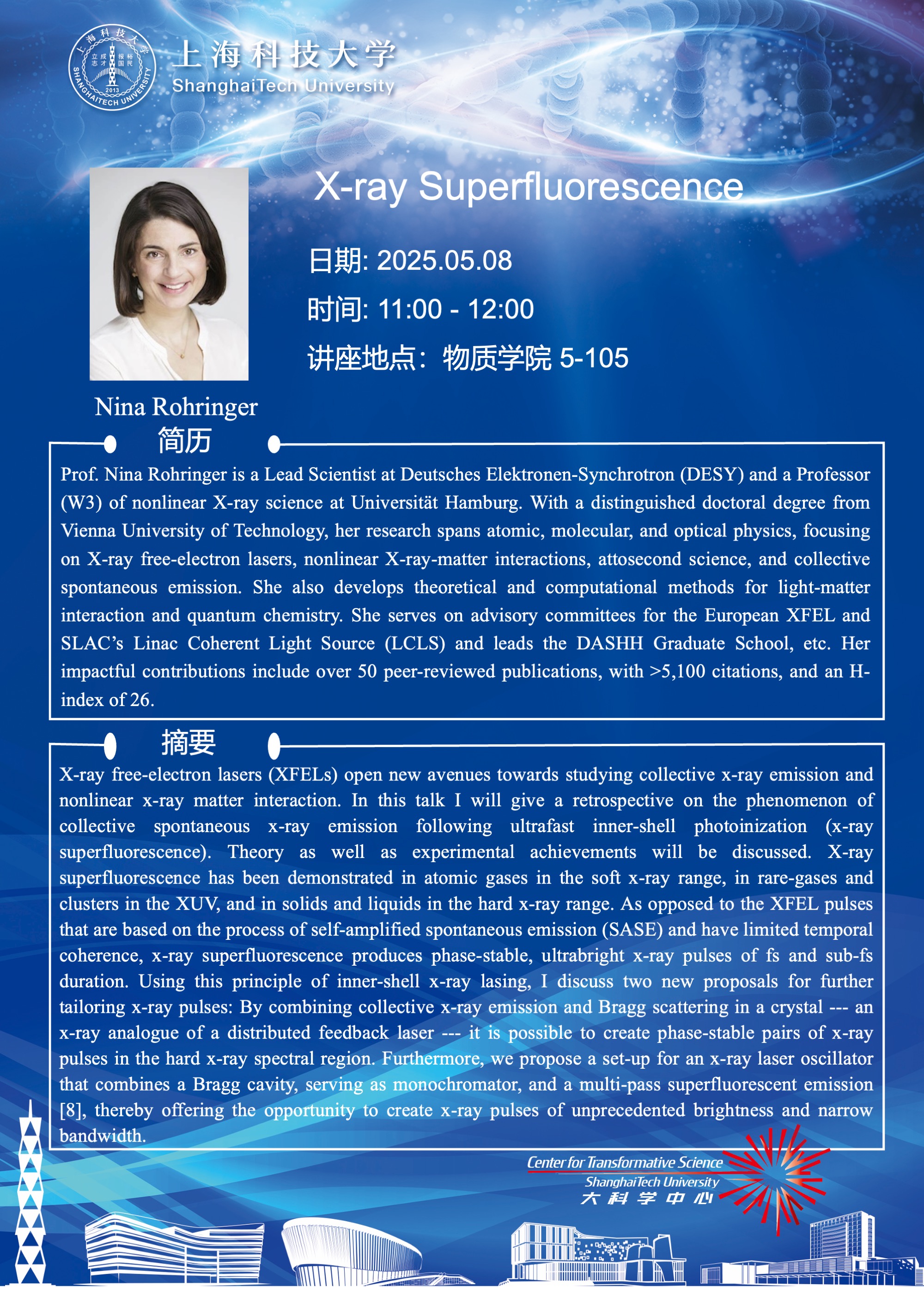
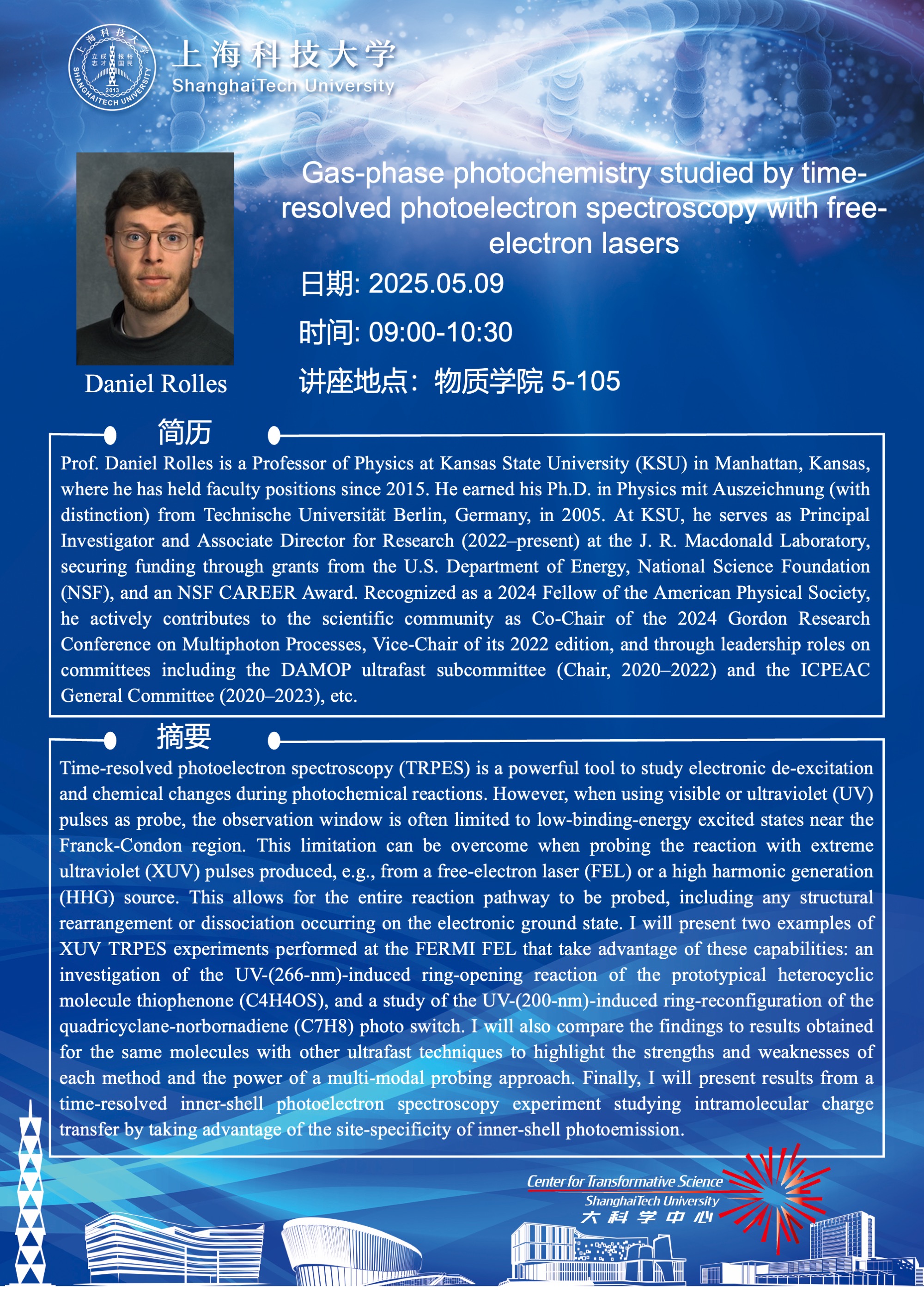
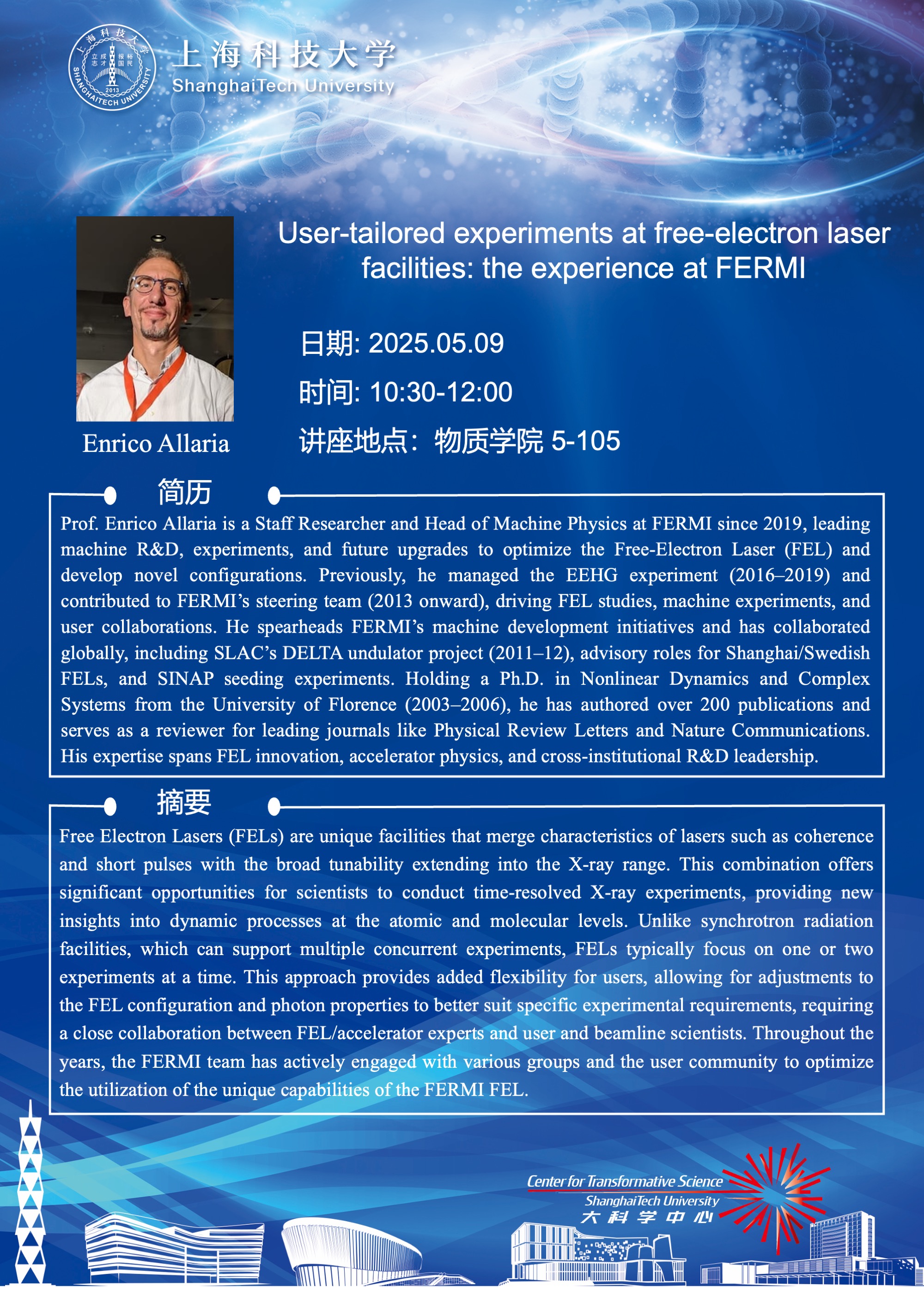
We will hold a joint seminar from May 07th to May 09th. Anyone interested in the seminar is welcome to join. Below, you will find the timetable and details about the talks.
Joint Seminars: https://reg.shanghaitech.edu.cn/cts/wufx2025/announcement.php?aid=26 | |
Wednesday 07 May: Shanghai Jiaotong University Joint Seminar on Ultrafast Science Program: https://reg.shanghaitech.edu.cn/cts/wufx2025/show_detail.php?aid=269&type=pdf&sp=F01 | |
Thursday 08 May: ShanghaiTech University Joint Seminar on Intense Field Science (SPST 5-105) | |
09:00-10:00 | Marcus Dahlström, Lund University Theory for Ultrafast Dynamical Photoemission: cases of dressed continuum, dressed atom and dressed ion |
10:00-11:00 | Alexander Kuleff, Heidelberg University Interatomic Coulombic Decay: The power of non-local relaxation mechanisms |
11:00-12:00 | Nina Rohringer, Deutsches Elektronen-Synchrotron (DESY) X-ray Superfluorescence. |
Friday 09 May: ShanghaiTech University Joint Seminar on AMO@XFEL (SPST 5-105) | |
09:00-10:30 | Daniel Rolles, Kansas State University Gas-phase photochemistry studied by time-resolved photoelectron spectroscopy with free-electron lasers. |
10:30-12:00 | Enrico Allaria, Elettra Sincrotrone Trieste User-tailored experiments at free-electron laser facilities: the experience at FERMI |
Friday 09 May, East China Normal University Joint Seminar on Ultrafast Science Program: https://reg.shanghaitech.edu.cn/cts/wufx2025/show_detail.php?aid=270&type=pdf&sp=F01 | |
---------------------------------------------------------------------------------------------------------------------------
Thursday 8 May: ShanghaiTech University Joint Seminar on Intense Field Science (SPST 5-105)
---------------------------------------------------------------------------------------------------------------------------
Marcus Dahlström, Lund University
Theory for Ultrafast Dynamical Photoemission: cases of dressed continuum, dressed atom and dressed ion
Free electron laser pulses at short wavelengths can be used to study strong coupling in atoms on ultrafast timescales. Phenomena include strong-field ionization from Rabi cycling atoms, dressed-atom stabilization, atomic stabilization in superintense laser fields, dynamic interference, and field-induced entanglement between photoelectrons and ions. In this seminar, various theoretical approaches will be reviewed for this area of physics, with a focus on analytical methods, such as few-level effective Hamiltonians and the Volkov propagator, with important interconnected concepts, such as gauge transformations and unitary transformations for time-dependent problems, being described in some detail. Highlights of the seminar will include strong-field Rabi dynamics and laser-assisted dynamic interference.
Alexander Kuleff, Heidelberg University
Interatomic Coulombic Decay: The power of non-local relaxation mechanisms
Interatomic Coulombic Decay (ICD) is a fundamental non-local relaxation mechanism occurring in weakly bound systems, where the excess energy of an excited atom or molecule is efficiently transferred to a neighboring species, leading to its ionization. Over the past decades, ICD has been recognized as a highly efficient mechanism for energy dissipation in various environments, from rare gas clusters to complex biological systems. In this talk, I will introduce the basic principles of ICD and explore its role in multiply excited clusters, where ICD cascades can sequentially ionize multiple atoms, leading to enhanced charge redistribution and fragmentation. The discussion will then focus on the relevance of ICD in the radiation damage of biomatter, emphasizing recent results on ICD and related processes in solvated biomolecules. In particular, the interplay between ICD and other decay pathways, such as Resonant-Auger-ICD cascades, will be presented in the context of radiation-induced damage at the molecular level. By highlighting recent theoretical and experimental advances, this talk aims to provide a comprehensive overview of how ICD and its cascading effects shape energy dissipation and charge redistribution in complex systems, with significant implications for radiation biology and medical applications.
Nina Rohringer, DESY
X-ray Superfluorescence
X-ray free-electron lasers (XFELs) open new avenues towards studying collective x-ray emission and nonlinear x-ray matter interaction. In this talk I will give a retrospective on the phenomenon of collective spontaneous x-ray emission following ultrafast inner-shell photoinization (x-ray superfluorescence). Theory as well as experimental achievements will be discussed. X-ray superfluorescence has been demonstrated in atomic gases in the soft x-ray range, in rare-gases and clusters in the XUV, and in solids and liquids in the hard x-ray range. As opposed to the XFEL pulses that are based on the process of self-amplified spontaneous emission (SASE) and have limited temporal coherence, x-ray superfluorescence produces phase-stable, ultrabright x-ray pulses of fs and sub-fs duration. Using this principle of inner-shell x-ray lasing, I discuss two new proposals for further tailoring x-ray pulses: By combining collective x-ray emission and Bragg scattering in a crystal --- an x-ray analogue of a distributed feedback laser --- it is possible to create phase-stable pairs of x-ray pulses in the hard x-ray spectral region. Furthermore, we propose a set-up for an x-ray laser oscillator that combines a Bragg cavity, serving as monochromator, and a multi-pass superfluorescent emission [8], thereby offering the opportunity to create x-ray pulses of unprecedented brightness and narrow bandwidth.
---------------------------------------------------------------------------------------------------------------------------
Friday 9 May: ShanghaiTech University Joint Seminar on AMO@XFEL (SPST 5-105)
---------------------------------------------------------------------------------------------------------------------------
Daniel Rolles, Kansas State University
Gas-phase photochemistry studied by time-resolved photoelectron spectroscopy with free-electron lasers
Time-resolved photoelectron spectroscopy (TRPES) is a powerful tool to study electronic de-excitation and chemical changes during photochemical reactions. However, when using visible or ultraviolet (UV) pulses as probe, the observation window is often limited to low-binding-energy excited states near the Franck-Condon region. This limitation can be overcome when probing the reaction with extreme ultraviolet (XUV) pulses produced, e.g., from a free-electron laser (FEL) or a high harmonic generation (HHG) source. This allows for the entire reaction pathway to be probed, including any structural rearrangement or dissociation occurring on the electronic ground state. I will present two examples of XUV TRPES experiments performed at the FERMI FEL that take advantage of these capabilities: an investigation of the UV-(266-nm)-induced ring-opening reaction of the prototypical heterocyclic molecule thiophenone (C4H4OS), and a study of the UV-(200-nm)-induced ring-reconfiguration of the quadricyclane-norbornadiene (C7H8) photo switch. I will also compare the findings to results obtained for the same molecules with other ultrafast techniques to highlight the strengths and weaknesses of each method and the power of a multi-modal probing approach. Finally, I will present results from a time-resolved inner-shell photoelectron spectroscopy experiment studying intramolecular charge transfer by taking advantage of the site-specificity of inner-shell photoemission.
Enrico Allaria, Elettra Sincrotrone Trieste
User-tailored experiments at free-electron laser facilities: the experience at FERMI
Free Electron Lasers (FELs) are unique facilities that merge characteristics of lasers such as coherence and short pulses with the broad tunability extending into the X-ray range. This combination offers significant opportunities for scientists to conduct time-resolved X-ray experiments, providing new insights into dynamic processes at the atomic and molecular levels. Unlike synchrotron radiation facilities, which can support multiple concurrent experiments, FELs typically focus on one or two experiments at a time. This approach provides added flexibility for users, allowing for adjustments to the FEL configuration and photon properties to better suit specific experimental requirements, requiring a close collaboration between FEL/accelerator experts and user and beamline scientists. Throughout the years, the FERMI team has actively engaged with various groups and the user community to optimize the utilization of the unique capabilities of the FERMI FEL.





